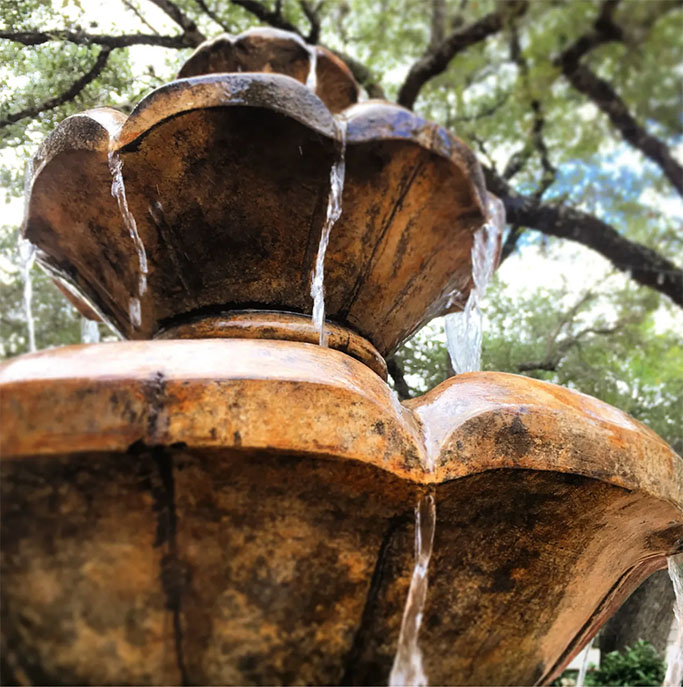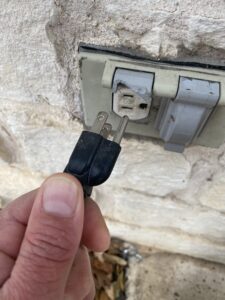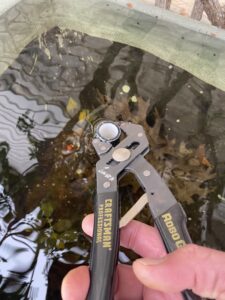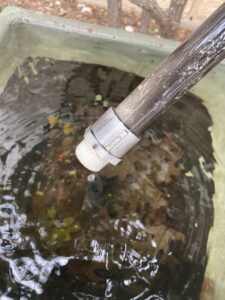
Winterizing Your Fountain
Generally speaking, we refer to a fountain as a feature with running water and no fish or plants. While some fountains may have plants in them, it is rare. Water runs over the top of the feature, into a basin and recirculates back to the top, and repeats. We have two primary types of fountains: Cast Stone Fountains and Disappearing Fountains.
Both types of fountains seem to be safe with temperatures as low as 32 degrees but we can get into trouble when temperatures dip below freezing and persist for more than 24-48 hours.
Note: Please, do not add automotive antifreeze to your fountain! Antifreeze is toxic to wildlife and pets! We understand that there are "nontoxic" alternatives but these are not approved or recommended by the fountain manufacturers.
Cast Stone Fountains:
Extreme and rapid changes in temperature affect all Cast Stone pieces adversely. It has an adherent tendency to expand and contract with climatic conditions. Your Cast Stone features have been designed with weather in mind. The cast-stone mix contains fibers and additives which enhance the elastic qualities of the cast-stone. Occasionally, normal, surface shrinkage cracks may sometimes appear, but your feature will not be destroyed due to freezes if these simple rules are followed:
Drain Cast Stone fountains before a major freeze event. Do not allow water to collect and freeze in the bowls or shells
Do not allow water to collect or freeze in birdbaths, saucers, or planters.
Do not allow statuary to sit in a pool of ice.
Cast Stone fountains should be turned off and drained when temperatures go below 32 degrees to avoid breakage due to the expansion of water caused by it forming into ice. As an extra precaution, towels or kitty litter can be placed in the “bowls” of the fountain to absorb excess moisture.
Disappearing Fountains:
Protecting Stone fountains - Natural stone fountains will need to be turned off/unplugged. And that's about it!
If your stone fountain is a carved bowl/planter (AKA Big Bend Stone), you'll want to vacuum or soak up any standing water left in the rock that may not have drained into the basin or stream! Kitty litter works great to soak up water. Covering container-shaped stones to prevent rain accumulation is recommended. These fountain features are super strong but we've seen a handful destroyed in the last 20 years. It's probably best to play it safe. Once the winter storm has passed, simply turn on/plug in your pump, and your up and running again.
Protecting Ceramic Fountains- All of the Asian pottery sold at HCWG is glazed and kiln-fired. This process produces a very weather-hardy, frost-resistant container. However, in extremely cold weather conditions it is recommended that you drain the pottery of water.
To drain your disappearing fountain:
- unplugging the pump
- remove the “standpipe”. To remove the standpipe, simply unscrew it from the bulkhead attached to the bottom of the pottery. A wrench may be necessary when unscrewing the PVC in cold Weather. This will allow the water to drain into the box-kit below.
- Store the standpipe and place a towel on the bottom inside of the pottery to absorb excess moisture.
There is no need to drain the plastic basin (unless you live north of the great state of Texas).
Wait for the freeze to pass, remove the towel, then replace standpipe, refill pottery with water, refill box-kit with water, and plug in the pump.



By following these simple and sensible precautions during the winter season, you will protect your fountains for years (and decades) of beauty and enjoyment.
updated: January 19, 2025


You must be logged in to post a comment.